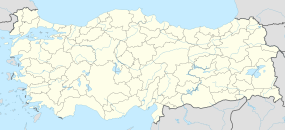Sapinuwa
 |
|
| Location | Çorum Province, Turkey |
|---|---|
| Region | Anatolia |
| Coordinates | 40°15′18.03″N 35°14′9.70″E / 40.2550083°N 35.2360278°ECoordinates: 40°15′18.03″N 35°14′9.70″E / 40.2550083°N 35.2360278°E |
| Type | Settlement |
| History | |
| Cultures | Hittite |
| Site notes | |
| Condition | In ruins |
Sapinuwa (sometimes Shapinuwa; Hittite: Šapinuwa) was a Bronze Age Hittite city at the location of modern Ortaköy in the province Çorum in Turkey. It was one of the major Hittite religious and administrative centres, a military base and an occasional residence of several Hittite kings. The palace at Sapinuwa is discussed in several texts from Hattusa.
Ortaköy was identified as the site of ancient Sapinuwa during a survey in 1989, and Ankara University quickly obtained permission from the Ministry of Culture to begin excavation. This commenced in the following year. Building A was excavated first, and then Building B in 1995. The building with the Yazılıkaya-style orthostate and 14th century BC charcoal was excavated after 2000. Aygül Süel has been the head of excavations at this site from 1996 onwards.
In the first excavated region was a Cyclopean-walled building dubbed "Building A". Building A has yielded 3000 tablets and fragments. They were stored in three separate archives on an upper floor, which collapsed when the building was burnt.
At Kadilar Hoyuk, 150 metres southeast of Building A, "Building B" has proven to be a depot filled with earthenware jars. Another building features an "orthostat that looks like the relief of Tudhaliyas at Yazilikaya".
The fire which destroyed Sapinuwa also damaged its archive. Most of the tablets are fragmentary, and must be pieced together before interpretation and translation.
Identification of the site as Sapinuwa immediately corrected a misunderstanding in Hittite geography. Due to the archives so far discovered at Hattusas, Sapinuwa had been thought to be a primarily Hurri-influenced city. Scholars of the Hattusas archive therefore positioned Sapinuwa to the southeast of Hattusa. Now Sapinuwa (and therefore the cities associated with it) are known to be to Hattusas's northeast.
The Building A tablets are mostly in Hittite (1500); but also in Hurrian (600), "Hitto-Hurrian", Akkadian, and Hattian. In addition, there are bilingual texts, not heretofore known, in Hittite / Hattian and in Hittite / Hurrian; vocabulary lists in Hittite / Sumerian / Akkadian; and seal impressions in Hieroglyphic Luwian. The Hittite texts include many letters; Hurrian was mostly used for itkalzi (purification) rituals. Several of the letters corresponded with those mentioned in the Maşat Höyük archive. The dialect of Hittite in that correspondence was Middle Hittite, but the site was in use for centuries afterward.
...
Wikipedia

